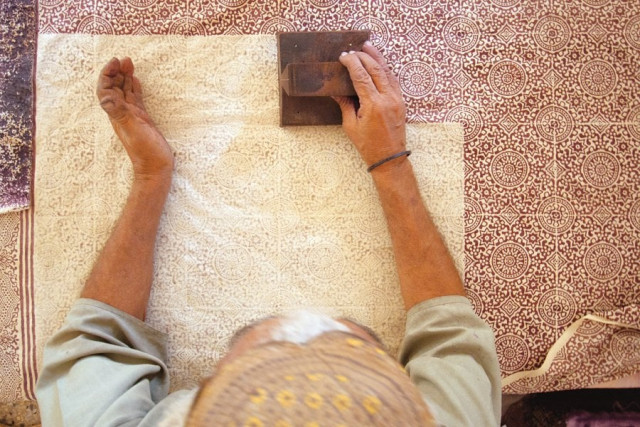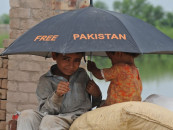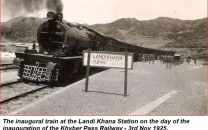The ageless ajrak
Over time, the colours of the ajrak have seeped deeper into society.

Over time, the colours of the ajrak have seeped deeper into society PHOTOS: DANIAL SHAH
Even before the fabric became a symbol of identity for Sindhis, it celebrated the existence of one of the earliest Indian civilisations known to man as the Indus Valley civilisation which flourished from 2500BC-1500BC. When Moen jo Daro was discovered in the second decade of the 20th century, the excavations brought to surface an assortment of material cultures. Among them was the terra-cotta statuary of the King Priest draped in a shawl with the trefoil motif (three-leaved plant). This impression of a woven cloth is now popularly marketed as the ajrak.

Ingredients used for ajrak making.
For the past 24 years, Noorjehan Bilgrami, an artist, textile designer and author of several books including Sindh Jo Ajrak, has conducted extensive research in the field and played a vital role in the revival of the craft in Sindh. In ‘Ajrak: Cloth from the soil of Sindh,’ published in the 2000 Textile Society of America Symposium Proceedings, she writes, “The trefoil is thought to be composed of three sun discs fused together to represent the inseparable unity of the Gods of Sun, Water and Earth.” Along with the pattern, even the technology of dyeing and printing of fabrics was adopted from the ancient civilisation after a dyer’s workshop was discovered at Moen jo Daro she writes, adding that the most notable dye, Indigo Ferra Tinetoria, grew along the banks of the River Indus.
Under British rule, the Bombay Presidency mastered the art of dyeing and printing fabric. Both Hindus and Muslims have since jointly contributed to its growth with Ajrakhpur, a tiny village in Kutch, India, striving as hard as the villages in lower Sindh, Pakistan, to keep the art alive.
Name and fame
Possibly derived from the Arabic azrak, believed to mean blue, it is said that ‘ajrak’ was adopted after the conquest of Sindh by Mohammed bin Qasim in 711 AD. Its craftsmen claim only if the fabric has the specific pattern and undergoes a specific printing process is it called an ajrak. In Sindh, the word is synonymous with pride as people wrap the fabric around their necks, drape it over their shoulders, wrap it into a turban and present it to others as a gesture of goodwill.
Respecting nature
At the heart of an ajrak is love for nature which is also the source of all its raw materials. These include dried pomegranate peel, katha (an essential ingredient in paan), alum, dried lemon, clay, indigo dye, sakun (a mixture of a tamarisk gall, molasses, castor oil, dried lemons and water), soda ash, mustard oil, kesu phool and alizarine (red dye). Even the manufacturing process makes use of renewable resources like sunlight, water and sustainable agriculture and mud, staying true to the thought behind the trefoil motif. Although the designs are not aniconic, of animals and humans, they symbolise the bounties of nature: stars, floral prints, indigo for twilight and red for the earth.

“The ajrak is made from natural materials and it is nonallergic. The cloth is strong and reliable, herbs are used and it [the cloth] acts as an insulator, [keeping] warm in [winter] and cool in [summer],” says Usto Allah Rehu, the owner of one of the biggest ajrak-making centres in Bhit Shah, Sindh. “Having labourers at my centre means I can produce more ajrak as well as provide jobs to the local people,” he says having employed a total of 22 workers at his set-up to whom he pays Rs3 to Rs22 per ajrak. By the end of the day a worker makes up to Rs400 to Rs500, he claims.
Abdul Aziz, on the other hand, runs a family-based business in Bhit Shah with his four bothers. He prefers to focus on quality rather than producing in bulk. “I am not satisfied selling an ajrak until I work on it myself from scratch to end,” he says, explaining how each brother specialises in a performing a particular task. Division of labour has helped this business prosper.
According to Rehu, people in the early ’60s stopped sourcing from nature and started importing the raw materials, particularly synthetic dyes. “[Over generations] we have lost the knowledge to utilise natural dyes. Before it was all natural but now at times we mix chemicals into it as well,” says Rehu, who admits that he is bound to use chemicals when the supply of natural materials runs short.

The series of complex processes that are followed to make the teli ajrak. PHOTOS: DANIAL SHAH
Despite efforts to sustain local indigo cultivation, ajrak makers have shifted to synthetic dyes due to easy use and availability in bulk explains Bilgrami. She has made several efforts to revive indigo cultivation, having also conducted a successful pilot project in Miani forest for four years. “Multan was a traditional centre where they grew indigo for exporting it to the Middle East as henna,” she says. “In Khairpur there was a farmer growing local indigo [on a small scale], but it has probably been stopped.”
The art of the craft
Having handed the knowledge down through generations, ustos (master-dyers and shop owners) have trained karigars (workers) who appoint their own chokro (trainee). While men do a majority of the work, women help from home.
Each ajrak goes through a series of complex processes that include preparation of the cloth, printing and finally dyeing. Ajrak centres across Sindh vary slightly in their process but prepare the final product within 20 to 30 days. Although it takes nearly a month to have the ajrak ready for sale, karigars work on multiple ajraks at a time and can have up to 40 ajraks ready within five to seven days.

The final product will now be distributed to shops to be sold. PHOTOS: DANIAL SHAH
The first stage of the process is to carve a design into a wooden block sourced from an acacia Arabia tree that is indigenous to Sindh. The skill of carving these blocks is also passed on from father to son but a few NGOs are now training people to keep the craft alive. The designs range from geometric patterns to flowers and stars and each block is duplicated with the design inverted for the double-printed cloth. After the block is ready to print, it is given a code based on the design, printing side on the cloth and the colour that will be used.

The final product will now be distributed to shops to be sold. PHOTOS: DANIAL SHAH
The second stage is to purchase the cotton cloth from a trusted vendor and prepare it for printing and dyeing. The dyeing process uses either the mordant or the resist techniques, or both. For the mordant technique, the cloth is first printed with the wooden block dipped in a substance that assists dye uptake and then submerged in dye allowing it to attach itself to the printed areas. And in resist printing, the areas that are secured by a dye-resistant paste remain white when dipped in dye. A series of complex processes are followed for the teli (oily) ajrak, whose colours intensify with use, and a few steps are excluded or skipped for the sabuni, do rangi and kori ajraks, accounting for comparatively inferior quality ajraks.
After cutting 10-metre long sheets from bales of cloth, enough to make a shawl, the fabric undergoes the process of khumbh. It is soaked in carbonate of soda and taken to the river to be washed — well oiled and soaped. Then it is covered in a quilt and undergoes steaming over a heated copper vat where it is placed through the night and the next day to allow the cloth to soften and steam to open up its pores so that impurities can be cleansed easily.
Saaj and kasai is the next crucial step. A mixture of camel dung, which acts as a bleaching agent, oil from Eruca Sativa (rocket plant) seeds and water is prepared for the fabric to soak in. The cloth is then left in firm bundles to dry for almost 10 days, depending on the weather. It is later spread out and left to dry under the sun. The soaking process is repeated three times using varying solutions — carbonate of soda and oil comprise the second solution and sakun is used for the third.

The final product will now be distributed to shops to be sold. PHOTOS: DANIAL SHAH
The dried cloth is then brought to the workshop for printing. First a white outline, chur, is printed on both sides of the cloth using the outline block dipped in kiryana, the resist paste made with rice paste, acacia gum and lime. Then kut, the process of printing the black areas begins. For this a mixture of iron sulphate, powdered tamarind seeds, gum and water are stamped on the cloth using a datta (filler block). Floral stars called phulli are printed onto the fabric at this stage.
The last stage of the printing involves the application of kharrh, a resist paste comprising Fuller’s earth, rice paste, alum, molasses, fennel and other herbs and gum. This is printed on white, black and areas that are to be later dyed red to protect them against indigo dye.
Now begins the dyeing process in which the usto dyes the fabric in cold water and synthetic indigo in a vat. The fabric is kept under the sun to dry before it is rigorously washed under running water to get rid of the resistant pastes and dye.
For the second stage in the dyeing process the cloth is dipped in a boiling sakun, alizarine and water solution in a large copper vat. The craftsmen repeatedly lift and immerse the cloth to register the rich red colour. Afterwards the fabric is immersed in a camel dung and water mixture for half a day to clear the white areas.
In tapai, the freshly dyed red fabric is washed in water mixed with soda ash first and then caustic soda to bleach the white area and allow the other colours to deepen. It is then sprinkled with water several times and dried. The meena process begins once the ajrak is taken to the workshop. The mud resistant paste used to cover the area for the red dye is printed on the fabric once more and immediately speckled with dried cow dung to allow it to dry.
Once again the ajrak is folded and dipped in the indigo vat, giving it its second shade of blue, and later dried and rolled into a bundle for a final wash called tiyari. It is then tightly folded while still damp and allowed to dry completely before being displayed at a shop for sale.
Making a comeback
The demand for ajraks is endless — locally and internationally. An ajrak is sold for Rs1,000 to Rs2,500 at smaller shops in Hala and Hyderabad, but can cost up to Rs5,000 at bigger shops in urban centres, depending on the design and quality. “Ajrak [making] is an art, but the artists are not valued. Their efforts are worth only a few rupees, where else everyone else, from the supplier of dyes, fabric and market [retailers], make a profit,” laments Aziz. Flooding the market with low-priced, machine printed ajrak imitations has worsened prospects for craftsmen who are increasingly abandoning the craft. But Rehu takes this as a positive reinforcement stating, “Buyers know the value of hardship and quality of hand-blocked traditional Ajrak.”
Many designers have also cashed in on the popularity of the ajrak. “The ajrak is not something trendy, it is a part of culture… it’s always in fashion,” says designer Nomi Ansari, who in the past has launched an ajrak-inspired collection. He claims to have used the traditional hand-crafted ajrak and incorporated it in his contemporary designs. According to him the inelastic demand for ajrak is in towns where it is more a matter of cultural pride. Therefore, the fabric “has always been around” and “should be around” he says.
“The ajrak is basically a design and a process. Now what you make of it depends on you,” says Rehu. “Of course you’ve to bring changes and blend it according to the fashion.”Along with trendy kameezes, ajrak bed sheets make a quite a bold fashion statement. With the recent convergence of politics and fashion, the ajrak has also transformed into a fabric with a message. Abdul Aziz even takes orders for contemporary political designs that have either ‘Jiye Sindh’, ‘Jiye Bhutto’ or ‘Jiye Asif Ali Zardari’ printed on them. By aligning agendas, the ajrak has perhaps paved its way into the future.
Danial Shah is travel writer and photographer who is always on the lookout for positive stories. He tweets @DanialShah_.
Published in The Express Tribune, Sunday Magazine, April 27th, 2014.


















COMMENTS
Comments are moderated and generally will be posted if they are on-topic and not abusive.
For more information, please see our Comments FAQ